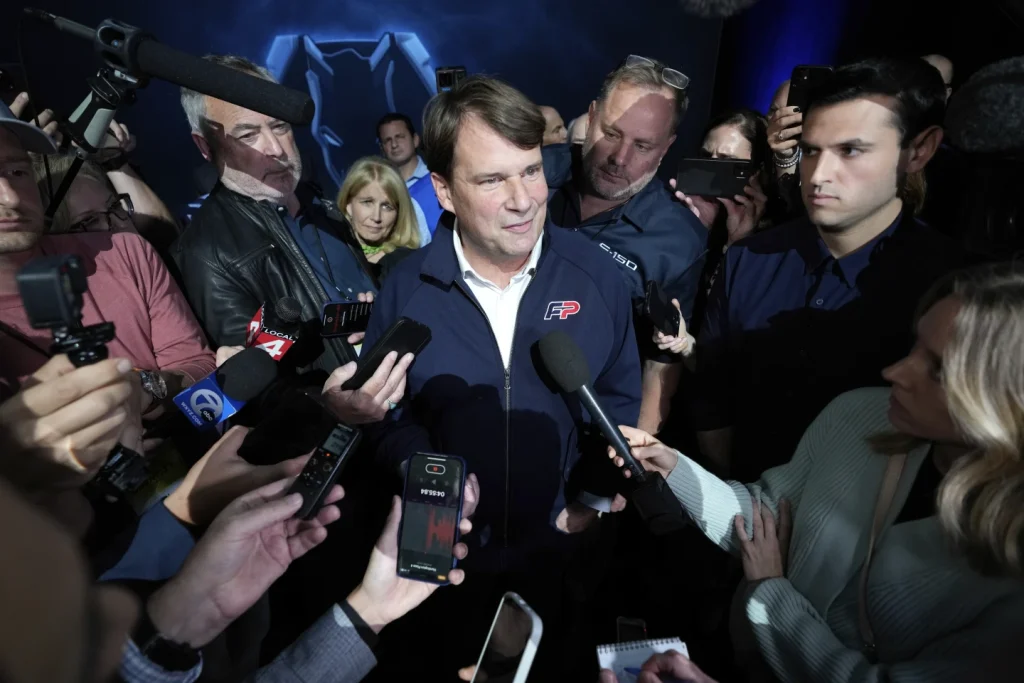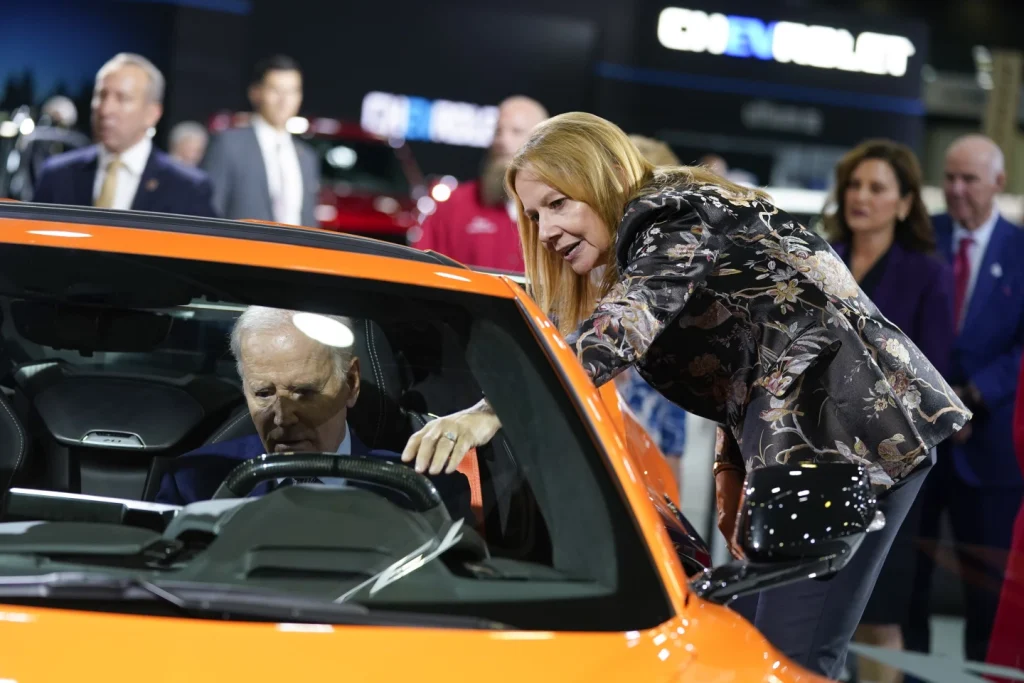In recent negotiations between the United Auto Workers (UAW) union and Detroit’s three automakers, the issue of CEO pay has emerged as a central argument.
UAW President Shawn Fain has consistently highlighted the fact that CEO pay has increased by 40% over the past four years, while autoworkers have only received a 6% raise since their last contract in 2019.
Fain initially demanded a 40% wage increase over four years, along with the reinstatement of pensions and cost of living adjustments.
Although the UAW has since revised their demand to a 36% wage increase, the two sides remain significantly apart in their contract negotiations, resulting in a strike.
Fain’s emphasis on CEO pay reflects a broader trend among labor unions, which are increasingly using the wealth disparity between workers and top executives as leverage to advocate for better compensation and working conditions.
This trend was evident in June when Netflix shareholders rejected executive pay packages after the Writers Guild of America urged investors to vote against them, citing the ongoing strike by writers in Hollywood.
The WGA also targeted executive pay at Comcast and NBCUniversal with similar letters.
Fain has vehemently refuted the assertions that granting the union a substantial increase in pay would inevitably lead to a surge in vehicle costs, thereby placing the three major automakers, General Motors, Ford, and Stellantis (formerly known as Chrysler), at a significant disadvantage compared to their foreign counterparts who benefit from the employment of lower-cost workforces in the ongoing race to embrace electric vehicles.
By challenging this line of reasoning, Fain highlights the complexities and nuances of the automotive industry’s transition towards electric mobility.
He argues that a narrow focus solely on labor costs fails to account for the broader factors influencing vehicle prices and competitive dynamics in the global market.
Fain’s counterargument underscores the need for a comprehensive analysis that encompasses various factors such as technological advancements, supply chain efficiencies, and economies of scale.
In doing so, he aims to dispel the notion that a higher pay scale for the union would inevitably hinder the Big Three’s ability to effectively compete in the burgeoning electric vehicle market.
In a recent interview on CBS’ “Face the Nation,” Fain, a representative of the United Auto Workers (UAW), defended the union’s request for a substantial 40% pay increase by highlighting the significant rise in CEO pay over the past four years, which also amounted to a 40% increase.
Fain argued that these CEOs were already millionaires, and thus, the demand for a fair share in the economy and the fruits of their labor was justified.
This assertion raises questions about the growing disparity between executive compensation and wages for ordinary workers, a trend that has persisted for decades.
However, upon closer examination, it becomes apparent that the UAW’s claim of 40% pay increases for the Big Three CEOs is not entirely accurate.
General Motors CEO, Mary Barra, expressed uncertainty about the origin of this figure during a press conference, indicating that the calculation of executive pay is complex due to the inclusion of stock grants and options.
A more detailed analysis of the compensation packages at all three companies reveals that the UAW’s claim both exaggerates and underestimates the reality, depending on the perspective taken.

THE BIG THREE CEO PAY PACKAGES
Barra, the sole individual who has held the role since 2019, stands as the highest paid executive, boasting a compensation package valued at a staggering $28.98 million in the year 2022.
Notably, a substantial portion of this package, amounting to $14.62 million, is comprised of stock grants that are subject to a three-year vesting period and whose ultimate worth hinges on stock performance and various other metrics.
As per data analyzed by Equilar for the AP, Barra’s remuneration has experienced a remarkable 34% increase since 2019.
In stark contrast, Ford CEO James Farley’s total compensation for 2022 amounted to nearly $21 million, signifying a 21% surge in comparison to his predecessor, Jim Hackett, who received $17.4 million in 2019, as indicated by the company’s proxy statements.
Farley’s compensation package for the preceding year encompassed stock awards worth $15.14 million, similarly subject to a three-year vesting period and reliant on performance for ultimate valuation.
However, when it comes to Stellantis, the comparison becomes intricate due to its formation in 2021 through the merger of Fiat Chrysler Automobiles and PSA Group.
Being a European entity, Stellantis divulges executive pay in a significantly different manner than GM and Ford.
In the recently published annual renumeration report, Stellantis, the multinational automotive company, disclosed that its CEO, Carlos Tavares, received a total pay of 23.46 million euros in 2022.
This figure represents a significant increase of nearly 77% compared to the 2019 pay of Mike Manley, the former CEO of Fiat Chrysler, which stood at 13.28 million euros.
These statistics were utilized by the United Auto Workers (UAW) when calculating the collective increase in CEO pay among three major automakers since 2019, revealing a substantial growth of 40.1% according to the UAW’s methodology shared with The AP.
However, it is important to note that there is a nuance to Stellantis’ reported figures. The numbers they presented encompass what is known as “realized pay,” which includes the value of previously granted equity that vested during the reporting year.
In contrast, U.S. companies typically employ the “grant date” value of stock packages awarded to executives during the reporting year.
To provide a more equitable comparison between the CEOs of Stellantis, Fiat Chrysler, and other companies, Equilar, an executive compensation data firm, conducted an analysis using the “grant date” method.
According to Equilar’s findings, Tavares’ compensation in 2022 amounted to 21.95 million euros, which includes 10.9 million euros in stock awards subject to a three-year vesting period.
Interestingly, when measured using this “grant date” approach, Tavares’ 2022 compensation actually reflects a decline of 24% compared to Manley’s 2019 compensation package, which Equilar calculated to be 29.04 million euros.
These contrasting perspectives shed light on the complexity of assessing CEO pay and highlight the importance of considering various methodologies when analyzing executive compensation.
THE VOLATILITY OF CEO PAY
The comparison between Tavares’ current compensation and Manley’s compensation four years ago may not accurately reflect the true disparity in their earnings.
This is because focusing solely on a CEO’s “realized pay” can sometimes obscure the exorbitant pay packages that are approved by company boards.
To illustrate this point, let’s examine Tavares’ compensation package for the year 2021. In addition to his regular compensation, Tavares received a special incentive award of 25 million euros in cash, along with stock valued at 19.56 million euros.
However, it is important to note that these additional rewards were contingent upon Tavares achieving long-term performance goals and were granted to him in recognition of his crucial role in leading the company through a merger.
When we consider this one-time award in conjunction with his regular compensation, it becomes evident that Tavares’ total compensation for 2021 far exceeds the amount received by Manley in 2019.

HOW DOES ALL THIS COMPARE TO REGULAR WORKER PAY?
Regardless of how you analyze the data, the difference in pay between CEOs and average workers at all three companies is staggering.
Take General Motors (GM) for example, where the median worker’s pay in 2022 was $80,034. It would take that worker a mind-boggling 362 years to earn the same annual compensation as GM’s CEO, Mary Barra.
Similarly, at Ford, with a median pay of $74,691, it would take 281 years to reach the CEO’s level of pay.
At Stellantis, the median pay of 64,328 euros would require 365 years to match the CEO’s compensation, although the company clarifies that this figure includes expenses related to a one-time grant. Excluding that, the pay ratio stands at 298-1.
The disparity between CEO and worker pay is extreme, no matter how you look at it. It far exceeds the typical pay gap seen at S&P 500 companies, which was 186-1 according to AP’s annual CEO pay survey.
This survey uses data analyzed by Equilar. Moreover, this disparity is astronomical when compared to historical standards.
In 1965, the CEO-to-worker pay ratio was a mere 15-1, according to a study conducted by the left-leaning Economic Policy Institute, which analyzed the 350 largest publicly traded U.S. firms.
The automakers argue that their foreign competitors pay their workers significantly less. For instance, workers at the Detroit 3 automakers receive around $60 per hour, including benefits, as reported by Harry Katz, a labor professor at Cornell University.
In contrast, workers at foreign-based automakers with U.S. factories earn approximately $40 to $45 per hour.
Then there’s Tesla. In the company’s proxy statement, CEO Elon Musk’s 2022 compensation was listed as zero, rendering the official pay ratio meaningless.
This is because Tesla has not awarded Musk any new compensation packages since their 2018 long-term plan, which could potentially be worth over $50 billion and is currently facing a legal challenge from shareholders.
However, the proxy statement reveals the staggering wealth disparity between Tesla’s nonunion workers and one of the world’s richest individuals.
Musk’s total “realized compensation” in 2021 was reported to be over $737 million, while a typical Tesla worker earned just $40,723 that year.
According to the proxy statement, it would take that worker over 18,000 years to earn Musk’s “realized compensation” for that same year.
